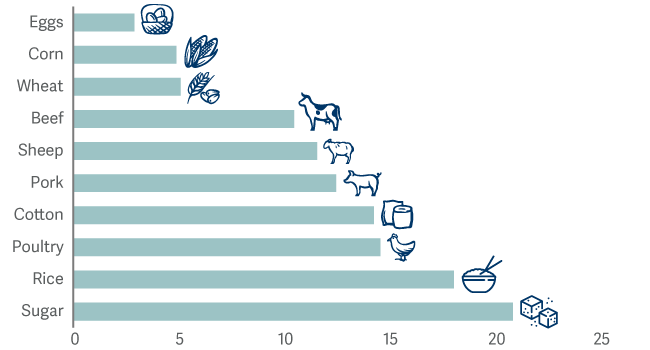By incentivising the production of unhealthy food, the current system of agricultural subsidies is damaging our health as well as our planet.
- Governments worldwide spend $540 billion on food subsidies every year
- Most of these subsidies are inefficient, degrade the environment and damage our health
- In the US, just 0.4% of subsidies are used to encourage the production of fresh fruit and vegetables
Iam privileged. Not everyone can afford to buy all the calories they need to survive – let alone to have access to a varied, balanced diet. In 2020, over 800 million people faced chronic hunger. So to complain about food subsidies, which have been critical in battling food poverty, may seem like a failure of empathy on my part…
Do I want to abolish food subsidies entirely? Of course not; millions of people still need subsidised food. But there is a real problem with the way in which agricultural subsidies work today…
This man wants your subsidies

It is estimated that governments worldwide currently provide subsidies worth around $540 billion to help farmers put food on the table. These support schemes were brought in after depressions, wars and famines. After all, most governments don’t want to see their populations starving to death. But are these subsidies always spent wisely?
What if I were to tell you that the UN estimates that around $470 billion (or 87%) of these subsidies are inefficient, inequitable, degrade the environment, hurt people’s health and distort food prices?
Is it right that – in many high-income countries – we can buy a beefburger at a quick-service restaurant chain for less than half the price it would cost without subsidies? This is an absurd situation. Given what we know today about the health and environmental implications of the diets that most of us eat today, why are we subsidising 99p cheeseburgers?
How we are getting subsidies wrong
First, we are subsidising the production of meat and dairy rather than fruit and vegetables. In the US, $38 billion is given to farmers in federal funding. Calculations in David Simon’s book Meatonomics show that only 0.4% of that is used to subsidise the production of fresh fruit and vegetables.
Can you guess where the rest goes? Just 3% of cropland is dedicated to fruit and vegetables but, partly because of the lack of subsidies, they make up 25% of the value of crops grown…
The 10 most incentivised agricultural commodities

With the incentives skewed so heavily in favour of meat and dairy production, is it any surprise to know only one-in-10 American adults meets the USDA’s recommendation that fruit and vegetables make up 50% of their diets. Sadly, the statistics are even worse for those living in poverty (they also happen to be the people with no access to healthcare…).
The second mistake the current subsidies system makes is to not account for the costs of climate change. While estimates vary, even the most conservative estimate shows that agriculture has a larger impact on climate change than all forms of transportation put together. Emissions from farm animals, synthetic fertilisers, burning of crop residues, cultivation and change in land use all contribute to the release of greenhouse gases.
At the same time, agricultural production and farming communities are particularly vulnerable to the impacts of climate change, such as extreme heat, rising sea levels, drought, floods and attacks by plant pests. These forces are already having an impact on many farmers and the situation will only get worse.
I am not suggesting that we end all subsidies…
… nor am I suggesting that the whole world moves to a plant-based diet (although from personal experience I can report that it’s not a bad idea). But a lot more could be done to spend the subsidies more wisely. They should vary by region, by income levels and by country. The goal should be:
- To feed more people, more healthily by actively subsidising foods with clearer nutritional benefits
- To reduce the impact of agriculture on the planet
- To end subsidies of unhealthy food whose production results in biodiversity loss and climate change
The current system of agricultural subsidies is broken. Whether your fast-food restaurant of choice is McDonalds, Shake Shack or Five Guys – or none of the above – a subsidised fast-food culture is clearly not the future any of us would wish for. Nor should it be today’s reality.
* The NRP quantifies, in relative terms, the extent to which a set of agricultural policies raise the producer price of a commodity and so incentivise producers

